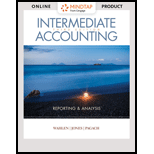
INTERM.ACCT.:REPORTING...-CENGAGENOWV2
3rd Edition
ISBN: 9781337909358
Author: WAHLEN
Publisher: CENGAGE L
expand_more
expand_more
format_list_bulleted
Question
Chapter 19, Problem 3C
1.
To determine
Describe the meaning of the interest cost component for the period of net pension cost and also state the manner in which company E should calculate the interest cost component of net pension cost for the period.
2.
To determine
Describe the meaning of prior service cost and also state the manner in which company E should account for prior service cost.
3.
To determine
State the conditions that the company should met for acquiring the compensation for future vacations, and explain the theoretical rationale for accruing compensation for future vacations.
Expert Solution & Answer
Want to see the full answer?
Check out a sample textbook solution
Students have asked these similar questions
What would be the total production engineering cost per unit
I want the correct answer with accounting question
Accounting
Chapter 19 Solutions
INTERM.ACCT.:REPORTING...-CENGAGENOWV2
Ch. 19 - Prob. 1GICh. 19 - Prob. 2GICh. 19 - Prob. 3GICh. 19 - Prob. 4GICh. 19 - Prob. 5GICh. 19 - Prob. 6GICh. 19 - Prob. 7GICh. 19 - Prob. 8GICh. 19 - Prob. 9GICh. 19 - Prob. 10GI
Ch. 19 - Prob. 11GICh. 19 - Prob. 12GICh. 19 - Prob. 13GICh. 19 - Prob. 14GICh. 19 - Prob. 15GICh. 19 - Prob. 16GICh. 19 - Prob. 17GICh. 19 - Prob. 18GICh. 19 - Prob. 19GICh. 19 - Prob. 20GICh. 19 - Prob. 21GICh. 19 - Prob. 22GICh. 19 - Prob. 23GICh. 19 - The actuarial present value of all the benefits...Ch. 19 - Prob. 2MCCh. 19 - Prob. 3MCCh. 19 - Prob. 4MCCh. 19 - Prob. 5MCCh. 19 - Prob. 6MCCh. 19 - Which of the following is not a component of...Ch. 19 - Prob. 8MCCh. 19 - Prob. 9MCCh. 19 - Prob. 10MCCh. 19 - Prob. 1RECh. 19 - Prob. 2RECh. 19 - Pinecone Company has plan assets of 500,000 at the...Ch. 19 - Prob. 4RECh. 19 - Prob. 5RECh. 19 - Prob. 6RECh. 19 - Prob. 7RECh. 19 - Prob. 8RECh. 19 - Given the following information for Tyler Companys...Ch. 19 - At the beginning of Year 1, Cactus Company has...Ch. 19 - Prob. 11RECh. 19 - Prob. 1ECh. 19 - Prob. 2ECh. 19 - Prob. 3ECh. 19 - Prob. 4ECh. 19 - Prob. 5ECh. 19 - Prob. 6ECh. 19 - Prob. 7ECh. 19 - Prob. 8ECh. 19 - Prob. 9ECh. 19 - Prob. 10ECh. 19 - Prob. 11ECh. 19 - Prob. 12ECh. 19 - Prob. 13ECh. 19 - Refer to the information provided in E19-13....Ch. 19 - Prob. 15ECh. 19 - Prob. 16ECh. 19 - Prob. 1PCh. 19 - Prob. 2PCh. 19 - Prob. 3PCh. 19 - Prob. 4PCh. 19 - Prob. 5PCh. 19 - Prob. 6PCh. 19 - Prob. 7PCh. 19 - Prob. 8PCh. 19 - Prob. 9PCh. 19 - Prob. 10PCh. 19 - Prob. 11PCh. 19 - Prob. 12PCh. 19 - Prob. 1CCh. 19 - Prob. 2CCh. 19 - Prob. 3CCh. 19 - Prob. 4CCh. 19 - Prob. 5CCh. 19 - Prob. 6CCh. 19 - Prob. 7CCh. 19 - Prob. 9C
Knowledge Booster
Similar questions
- Brun Company produces its product through two processing departments: Mixing and Baking. Information for the Mixing department follows. Direct Materials Conversion Unit Percent Complete Percent Complete Beginning work in process inventory 7.500 Units started this period 104,500 Units completed and transferred out 100.000 Ending work in process inventory 12.000 100% 25% Beginning work in process inventory Direct materials Conversion $6.800 14.500 $21.300 Costs added this period Drect materials 116,400 Conversion Total costs to account for 1.067,000 1.183.400 $1.204.700 Required 1. Prepare the Mixing department's production cost report for November using the weighted average method Check (1) C$1.000 2. Prepare the November 30 journal entry to transfer the cost of completed units from Mixing to Bakingarrow_forwardNonearrow_forwardNot need ai solution please solve this general accounting questionarrow_forward
- What is the amount of current liabilities the firm has?arrow_forwardNeed answer of this question with financial accountingarrow_forwardThompson Aggrotech has a return on equity of 14.85 percent, a debt-equity ratio of 0.65, and a total asset turnover of 1.1. What is the return on assets?arrow_forward
arrow_back_ios
SEE MORE QUESTIONS
arrow_forward_ios
Recommended textbooks for you
 Intermediate Accounting: Reporting And AnalysisAccountingISBN:9781337788281Author:James M. Wahlen, Jefferson P. Jones, Donald PagachPublisher:Cengage Learning
Intermediate Accounting: Reporting And AnalysisAccountingISBN:9781337788281Author:James M. Wahlen, Jefferson P. Jones, Donald PagachPublisher:Cengage Learning Individual Income TaxesAccountingISBN:9780357109731Author:HoffmanPublisher:CENGAGE LEARNING - CONSIGNMENT
Individual Income TaxesAccountingISBN:9780357109731Author:HoffmanPublisher:CENGAGE LEARNING - CONSIGNMENT

Intermediate Accounting: Reporting And Analysis
Accounting
ISBN:9781337788281
Author:James M. Wahlen, Jefferson P. Jones, Donald Pagach
Publisher:Cengage Learning


Individual Income Taxes
Accounting
ISBN:9780357109731
Author:Hoffman
Publisher:CENGAGE LEARNING - CONSIGNMENT